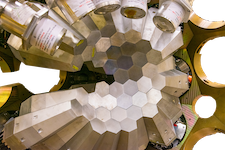Speakers
Description
Superallowed 0+→ 0+ β decay in light nuclei gives the most accurate Vud, the up-down mixing element of the Cabibbo-Kobayashi-Maskawa (CKM) matrix. In the Standard Model (SM), the matrix is supposed to have unitarity. The unitarity of the CKM matrix ensures that the three generations of quarks form a complete set of quark elements. In other words, the non-unitarity of the matrix implies the existence of hidden physics, such as the existence of the fourth-generation quarks [Ma86]. The unitarity can be tested through the examination of the square sum of the first column elements: |Vud|2 + |Vus|2 + |Vub|2. It should be unity in the regime of SM, but the current value is slightly smaller than one. Among the matrix elements, Vud is critical because the value dominates the sum. Historically, uncertainties inherited from hadronic interactions take a large fraction of the total uncertainty of Vud. Recently, several works successfully reduced hadronic uncertainty. Ref. [Se18] re-estimated the radiative correction to be 0.02467(22), and it led to the 4-sigma difference, 0.9984(4), of the squared sum of the column elements in the CKM matrix from the unitarity.
The reduction of the theoretical uncertainty and a crack of solidity on the unitarity provides the new motivation for re-measuring Ft values, especially on the light nuclei, which can impact the overall results. In particular, the Ft value of 10C β decay slightly deviates from the average Ft value keeping large uncertainty [Ha20]. Thus, a new measurement of Ft for the 10C β decay deserves to have a priority. Moreover, the new measurement for 10C can have an impact on the search for Fierz interference term as well.
For the last three decades, only three measurements [Sa95, Fu99, Bl20] have been reported. Among them the two measurements [Sa95, Fu99] have a similar setup but their uncertainty budget was very different. These non-compatible results put a question mark on the systematic error analysis of the measurements.
We suggest a new experiment with the AGATA. A Tendem beam of 20-pnA proton at an energy of 15 MeV will impinge on a 2-um-thick, self-supporting 10B target to produce 10C nuclei through (p,n) reaction. The reaction 10B(p,p’)10B* will be exploited to measure the in-beam efficiency ratio 𝜀(718𝑘𝑒𝑉)/𝜀(1022𝑘𝑒𝑉) from the transition at 2.154 MeV. The ratio is directly estimated from the γ-ray spectrum gated on the 414-keV γ-ray peak. The compact configuration of AGATA and capability for dealing with the pileup events is expected to significantly reduce the background coming from the 511-keV γ rays. In total 10 days of beam time will be requested.
References
[Ma86] W. J. Marciano and A. Sirlin, Phys. Rev. Lett. 56, 22 (1986).
[Se18] C.-Y. Seng et al., Phys. Rev. Lett. 121, 241804 (2018).
[Ha20] J. C. Hardy and I. S. Towner, Phys. Rev. C 102, 045501 (2020).
[Sa95] G. Savard et al., Phys. Rev. Lett. 74, 1521 (1995).
[Fu99] B. K. Fujikawa et al., Phys. Lett. B 449, 6 (1999).
[Bl20] B. Blank et al., Eur. Phys. J. A 56, 156 (2020).

